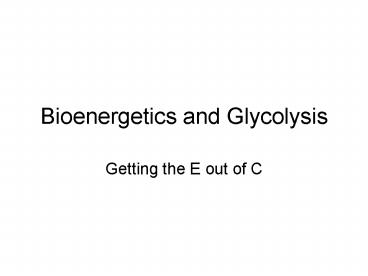Bioenergetics and Glycolysis - PowerPoint PPT Presentation
1 / 34
Title:
Bioenergetics and Glycolysis
Description:
Bioenergetics and Glycolysis Getting the E out of C gluconeogenesis Making glucose from pyruvate In liver Uses same enzymes as glycolysis except where nonequilibrium ... – PowerPoint PPT presentation
Number of Views:278
Avg rating:3.0/5.0
Title: Bioenergetics and Glycolysis
1
Bioenergetics and Glycolysis
- Getting the E out of C
2
Overall Chemical Reaction
- For all of Cellular Respiration
- C6H12O6 6 O2 ---? 6 CO2 6 H2O
- Overall free energy 687 kcal/mol or 3.8 kcal/g
- Not really that efficient
- (Stay tuned for the actual)
3
Energy Transfer follows thermodynamic laws
- Gibbs helmholtz
- ?G ?H T?S
- Enthalpy
- Entropy
- Remember ?Suniverse gt 0 is a spontaneous process
- Overall if ?G lt 0 the process is spontaneous
- ?G -RTlnK
- Relates ?G to equilibrium
- ?G are additive
- State function
- Overall ?G has to be for a process to be
spontaneous
4
Le Chateliers Principle and ?G
- Remember Le Chatelier and affect on equilibrium
- If one reaction has a positive ?G, but the next
reaction, which is in equilibrium has a negative
?G , the first reaction can be pulled through - Many examples of this in glycolysis
5
ATP (Adenosine Tri-Phosphate)
6
Hydrolysis of ATP
ATP
------? ADP Pi 7.3 kcal
7
Energy from ATP hydrolysis
- 7.3 kcal /mol (30.5 kJ/mol for you SI nuts)
- Energy from
- Separation of negative charges
- Increased entropy
- Phosphate now free2 things instead of one
- Resonance stabilization of phosphate
8
Other Energy sources
- Hydrolysis of thioester
- Resonance stabilization of carboxylate
- Energy released from group transfer, not simply
hydrolysis - Coenzyme A (CoA) is an important thiol that forms
thioesters
9
Coenzyme A
10
Redox
- Review
- Electron transfer reactions
- Energy from electron transfer
- Electrons typically transferred to a carrier
- NAD 2 e- 2H -? NADH H
- FAD 2 e- 2H -? FADH2
- Electrons transferred later for ATP generation
11
NAD (Nicotinamide Adenine Dinucleotide)
12
Reduction of NAD on Nicotinamide Ring
13
FAD (Flavin Adenine Dinucleotide)
14
Reduction of Flavin Ring on FAD
15
Glycolysis
- In Cytosol
- Anaerobic
- Breakdown of glucose to two pyruvate molecules
- Glucose 2 ADP 2 Pi 2 NAD -? 2 pyruvate 2
ATP 2 NADH 2 H - C6H12O6 2 ADP 2 Pi 2 NAD -? 2 C3H3O3- 2
ATP 2 NADH 2 H
16
Glycolysis
17
Hexokinase reaction
- Irreversible
- Kinase (phosphate transfer)
- -16.7kJ
18
Hexose phosphate isomerase reaction
- Keto-aldol isomerization
- Glucose to fructose
- 1.7 kJ
19
Phosphofructokinase reaction
- Same as hexokinase reaction
- -14.2kJ
- Major point of regulation
- Committed step
- Stimulated by ADP and AMP
- Inhibited by ATP and fatty acids
20
Aldolase Reaction
- Reverse aldol condensation
- 23.8kJ
- Makes 2 3-Carbon molecules
21
Triose phosphate isomerase
- Keto-enol isomerization (like hexose phosphate
isomerase reaction) - 7.5kJ
- Net is 2 glyceraldehyde 3 phosphate
- From now on each reaction times 2
22
Glyceraldehyde -3-phosphate dehydrogenase
- Oxidation coupled to phosphorylation
- Makes NADH
- 6.3kJ
- (remember X 2)
23
Phosphoglycerate Kinase
- Phosphate transfer
- Substrate level phosphorylation
- Driven by stabilization of carboxylate
- -18.5kJ
- Pulls previous reactions through
24
Phosphoglycerate mutase
- Moves from 3 -? 2
- 2 steps
- Makes 2,3
- Removes 3
- 4.4kJ
25
enolase
- Makes unstable enol intermediate
- 7.5 kJ
26
Pyruvate kinase
- Last reaction.woohoo
- Substrate level phosphorylation
- Stabilization of enol -? keto
- -31.4kJ
27
Net products from Glycolysis (per glucose)
- 2 pyruvate
- 2 NADH
- 2 ATP
- Total energy -61.3 kJ
- Sum of energies
28
Fates of pyruvate
29
Fates of Pyruvate
- Depend on organism and conditions
- Yeast
- Anaerobic
- Pyruvate decarboxylase
- Makes alcohol
- Aerobic
- Makes acetyl CoA ---? energy or fat
- Others
- Anaerobic
- LDH
- Makes lactate
- Sore muscles
- Aerobic
- Acetyl Co A ---? energy or fat
30
Glycogen
31
Glycogenolysis
32
Glycogen breakdown
- Glycogen phosphorylase breaks down alpha 1,4
linkages - Makes glucose-1-phosphate
- Enzyme changes to glucose-6-phosphate and enters
glycolysis there - Cant break 1,6 linkages
- Debranching enzyme breaks 1,6 (when 4 sugars away
from branch) and adds to end - Glycogen phosphorylase takes over and breaks down
the rest
33
Other sugars
- Fructose
- Comes in at fructose-6-p and immediately
phosphorylated - Lipogenicafter branch to glycogenmakes acetyl
CoA - Lactose
- Glucose and galactose
- Galactose
- Epimerase turns into glucose-6-P and enters there
34
gluconeogenesis
- Making glucose from pyruvate
- In liver
- Uses same enzymes as glycolysis except where
nonequilibrium reactions - Uses NADPH instead of NADH































